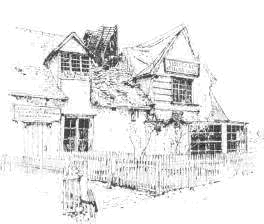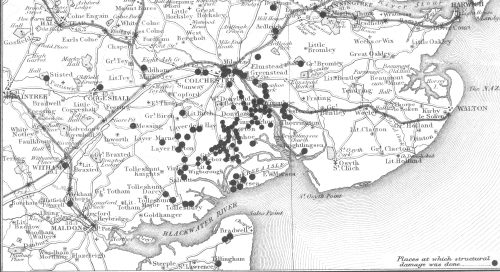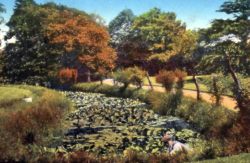The Essex Earthquake 1884
At 9.20 am on 22 April 1884 an earthquake
struck the United Kingdom with the epicentre at Abberton which is a
small village to the south east of Colchester on the north bank of
the River Blackwater.
Previous earthquakes had
occurred in Essex at Saffron Walden in 1580 and Witham in 1692.
 Damage
to the Peldon Rose Public House which was near the epicentre
Damage
to the Peldon Rose Public House which was near the epicentre
The earthquake was measured
at 5.2 on the Richter scale and is considered to be the most severe
recorded in the UK with shocks felt for a radius of 180 miles as far
as Altringham in the North and Isle of Wight in the south.
The ground shook for between
two and thirty seconds depending on the location and geology of the
area.
A succeeding earth tremor
took place on 24 June 1844 but caused no damage.
Between 12 and 1300 buildings
were damaged including 20 churches and 11 chapels.
Most of the damage occurred
within an area of about 50 square miles centred on North East Essex.
The earthquake was probably
due to movement along a fault in the ancient Paleozoic rocks under
Essex, which would have affected the overlying cover of Cretaceous
and Tertiary strata.
 A
map of damage caused by the earthquake
A
map of damage caused by the earthquake
The effects on The Dengie
Hundred were quite dramatic where many houses and building suffered
from minor damage and people throughout the District ran into the
street from houses or building following the noise and tremors not
realising what was happening.
The events were recorded in a
diary kept by Rev John Mills who was the Rector of St Lawrence.
April 22 1884
“About 9.20am on Tuesday April 22, a very severe earthquake took
place in this district. It lasted only a very few seconds, but it
wrecked many buildings, Churches, etc at Wyvenhoe, Colchester,
Langenhoe and Peldon , even Bradwell suffered severely and
Tillingham somewhat.
The
shock was felt very distinctly in this parish, and the houses, the
church and school, etc were rocked and twisted to and fro, but by
God's mercy no harm was done, except that a few tiles were shaken
from Motts Farm.
People on horseback and in carriages did not generally feel it"
Local newspapers recorded the effects of
the earthquake on local people. Some of the reported events are
listed below.
|
Althorne |
Mr John Rogers at Stokes Hall reported that his clock
stopped with the pendulum stuck at a strange angle |
|
Asheldham |
Tremors felt but no damage reported |
|
Bradwell on Sea |
About 40 Chimney Stacks were damaged. At Weymarks farm
only one chimney remained on the three farmhouses and
the farmhouse was badly damaged. The Church tower was
shaken with the roof partly untiled and a chimney stack
fell from the Rectory. Several windows were broken at
East hall. 180 Children at the village school panicked
and ran into the street. |
|
Burnham on Crouch |
Rumbling noise
heard, pictures swung on their hooks. Turbulence on the
River Crouch frightened local fishermen so much that
they refused to go back onto the River for several days. |
|
Dengie |
Shock felts
pictures on walls moved |
|
Latchingdon |
2 clocks stopped
at 0920 at the home of Mrs E A Fitch |
|
Mayland |
Shock felt |
|
River Blackwater |
Stansgate
Coastguard's were on patrol in the River Blackwater when
the quake struck. The crew rowed back to base as the
leader was convinced that a torpedo had exploded amongst
shipping nearby. Waves in the
River Blackwater were of sufficient strength to force
two Thames barges backwards against their sails. |
|
St Lawrence |
Tiles shaken from
the roof of Motts Farm |
|
Southminster |
Rev Berkeley in
vicarage felt the floor move and saw his dining room
wall sway. He then heard two of the church bells ring of
their own accord. A later examination of the vicarage
showed that 3 chimney stacks were badly damaged and
needed to be replaced. William Page in
Southminster Hall saw his gaselier swing, his dining
room clock stopped and he noticed that the water in his
moat was very agitated.
|
|
Tillingham |
The villagers
reported tremors and them complained of strange vapours.
About 6 chimneys knocked down. |
Neighbouring Maldon suffered with the weights falling from the moot hall clock greatly alarming Head Constable Wombwell and PC Parrot who had rushed from the Police Station in Moot Hall following the tremors.
On a lighter note at Maldon
it is recorded that a pet cockatoo suffered from the tremors by
falling from its perch!
A national relief fund was
started that was to provide over £9,000 for repairs to houses
damaged by the earthquake.
Bradwell on Sea was the main
beneficiary in Eastern Essex with the Church and 27 other buildings
receiving financial help with the repairs.
Thus Eastern Essex survived a
brush with the worst earthquake in the country's history.

 Southminster Moat
Southminster Moat

